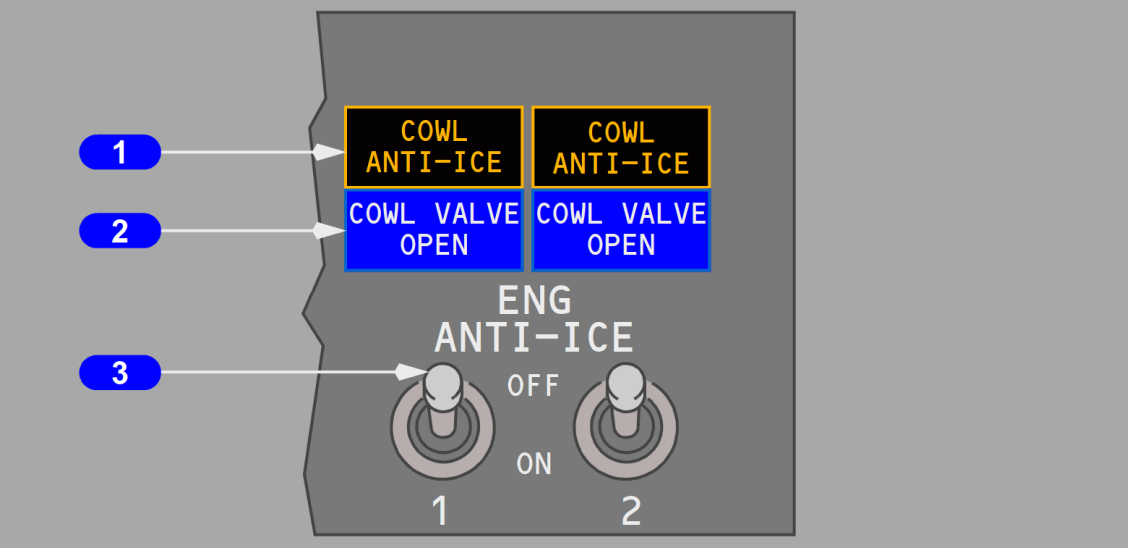问题1:在紧急下降检查单中要求双发油门杆减到最小或根据防冰情况按需调节,是否意味着在慢车位置不能打开发动机防冰活门?
波音回复如下:
RESPONSE:
The intent of the step is to maintain adequate thrust to ensure the engine anti-ice valves are open. If the thrust is adequate, the COWL VALVE OPEN lights are illuminated dim and the amber TAI alert is not displayed. If the COWL VALVE OPEN lights remain illuminated bright with the engines at idle, the thrust should be increased slightly, up to a minimum of 30% N1.
这一步骤的目的是保持足够推力以确保发动机防冰活门打开,如果推力足够COWL VALVE OPEN灯是暗亮,琥珀色TAI不会显示,如果发动机在慢车时COWL VALVE OPEN灯保持明亮,推力应该缓慢增加直到最小30% N1。
问题2
为什么在人工恢复和飞行操纵卡阻受限检查单中不需要将TCAS模式设置 TA 或者TA only模式?
波音回复如下:
RESPONSE:
All non-normal checklists are evaluated on a case-by-case basis. There are no blanket criteria defining when the Transponder Mode selector must be set to TA because malfunctions are very situational. Putting the Transponder Mode selector to TA into all relevant checklists is not done because, depending on the extent of the malfunction and the conditions, there may be capability to accomplish an RA action. The probability of a severe malfunction, which limits climb capability and/or maneuverability, combined with a RA event are low enough that it does not warrant a TCAS-TA step in many checklists.
所有非正常的检查表都是根据具体情况进行评估的。由于故障非常具有情境性,因此没有明确的标准来定义应答器模式选择器何时必须设置为TA。将应答器模式选择器放入所有相关的检查清单中是不可行的,因为根据故障的程度和条件,可能有能力完成RA操作。严重故障(限制爬升能力和/或机动性)与RA事件相结合的概率很低,因此在许多检查清单中不需要进行TCAS-TA步骤。
问题3
如果在低于飞行高度层 FL220 的爬升和下降过程中一个 DEU 失效且失效侧自动驾驶接通,
• 两个飞行员飞行显示上的飞行指引仪俯仰指令杆消失
• 在高度截获( ALT ACQ)时飞行指引仪俯仰指令杆重新出现
• 自动驾驶接通于 CWS P 方式
• 失效侧自动驾驶的高度层改变( LVL CHG), VNAV 与 V/S 不可用。
如果 DEU 在飞行高度层 FL220 以上时失效,自动驾驶与飞行指引仪不受影响。
为什么高度220是一个临界高度?
波音回复如下:
RESPONSE:
FL220 is a function of the Stall Management Yaw Damper (SMYD) Computer logic. Above approximately 22,000ft, the FMC provides the minimum maneuver (buffet) speed to the autopilot, which is unaffected by a single DEU failure. Below 22,000ft, the autopilot uses the SMYD minimum maneuver speed, which is dependant on the DEU engine data. A failure of the DEU below 22,000ft prevents the autopilot from operating in pitch modes that control to airspeed or thrust.
As stated above, the minimum maneuver airspeed is calculated by the SMYD computer. The buffet speed is calculated by the FMC. The SMYD computer compares the minimum maneuver airspeed with the buffet speed and transmits the higher of the two values to the FCC. At low altitudes, the minimum maneuver speed is the larger of the two. At high altitudes, the buffet speed is the larger of the two. The crossover point occurs at approximately 22,000 feet, depending on gross weight.
FL220是失速管理偏航阻尼器(SMYD)计算机逻辑的功能。在大约22,000英尺以上,FMC为自动驾驶仪提供最小机动(抖振)速度,该速度不受单个DEU故障的影响。在22,000英尺以下,自动驾驶仪使用SMYD最小机动速度,这取决于DEU发动机数据。如果DEU在22,000英尺以下发生故障,自动驾驶仪将无法在控制空速或推力的俯仰模式下运行。
如上所述,最小机动空速由SMYD计算机计算的。抖振速度由FMC计算。SMYD计算机将最小机动空速与冲击速度进行比较,并将两个值中的较高值发送给FCC。在低空,最小机动速度是两者中较大的。在高海拔地区,抖振速度是两者中较大的。交叉点大约在22,000英尺处,取决于总重量。


评论 (0)